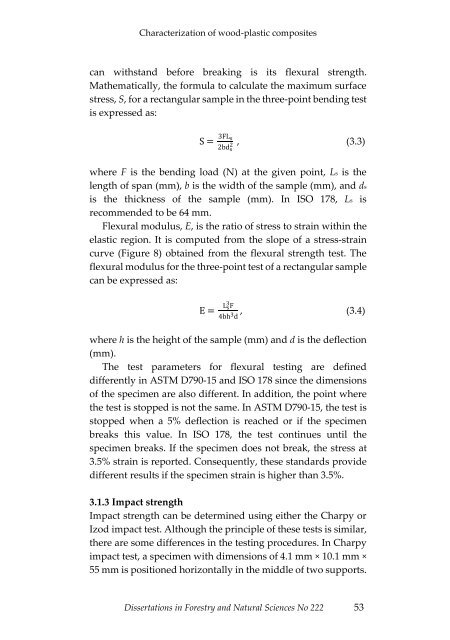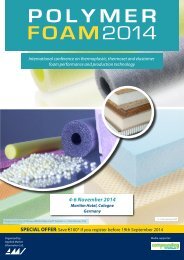Dissertations in Forestry and Natural Sciences
24lYKFN
24lYKFN
Create successful ePaper yourself
Turn your PDF publications into a flip-book with our unique Google optimized e-Paper software.
Characterization of wood-plastic composites<br />
can withst<strong>and</strong> before break<strong>in</strong>g is its flexural strength.<br />
Mathematically, the formula to calculate the maximum surface<br />
stress, S, for a rectangular sample <strong>in</strong> the three-po<strong>in</strong>t bend<strong>in</strong>g test<br />
is expressed as:<br />
S = 3FL s<br />
2bd s<br />
2 , (3.3)<br />
where F is the bend<strong>in</strong>g load (N) at the given po<strong>in</strong>t, Ls is the<br />
length of span (mm), b is the width of the sample (mm), <strong>and</strong> ds<br />
is the thickness of the sample (mm). In ISO 178, Ls is<br />
recommended to be 64 mm.<br />
Flexural modulus, E, is the ratio of stress to stra<strong>in</strong> with<strong>in</strong> the<br />
elastic region. It is computed from the slope of a stress-stra<strong>in</strong><br />
curve (Figure 8) obta<strong>in</strong>ed from the flexural strength test. The<br />
flexural modulus for the three-po<strong>in</strong>t test of a rectangular sample<br />
can be expressed as:<br />
E =<br />
L s 3 F<br />
4bh 3 d , (3.4)<br />
where h is the height of the sample (mm) <strong>and</strong> d is the deflection<br />
(mm).<br />
The test parameters for flexural test<strong>in</strong>g are def<strong>in</strong>ed<br />
differently <strong>in</strong> ASTM D790-15 <strong>and</strong> ISO 178 s<strong>in</strong>ce the dimensions<br />
of the specimen are also different. In addition, the po<strong>in</strong>t where<br />
the test is stopped is not the same. In ASTM D790-15, the test is<br />
stopped when a 5% deflection is reached or if the specimen<br />
breaks this value. In ISO 178, the test cont<strong>in</strong>ues until the<br />
specimen breaks. If the specimen does not break, the stress at<br />
3.5% stra<strong>in</strong> is reported. Consequently, these st<strong>and</strong>ards provide<br />
different results if the specimen stra<strong>in</strong> is higher than 3.5%.<br />
3.1.3 Impact strength<br />
Impact strength can be determ<strong>in</strong>ed us<strong>in</strong>g either the Charpy or<br />
Izod impact test. Although the pr<strong>in</strong>ciple of these tests is similar,<br />
there are some differences <strong>in</strong> the test<strong>in</strong>g procedures. In Charpy<br />
impact test, a specimen with dimensions of 4.1 mm × 10.1 mm ×<br />
55 mm is positioned horizontally <strong>in</strong> the middle of two supports.<br />
<strong>Dissertations</strong> <strong>in</strong> <strong>Forestry</strong> <strong>and</strong> <strong>Natural</strong> <strong>Sciences</strong> No 222 53



